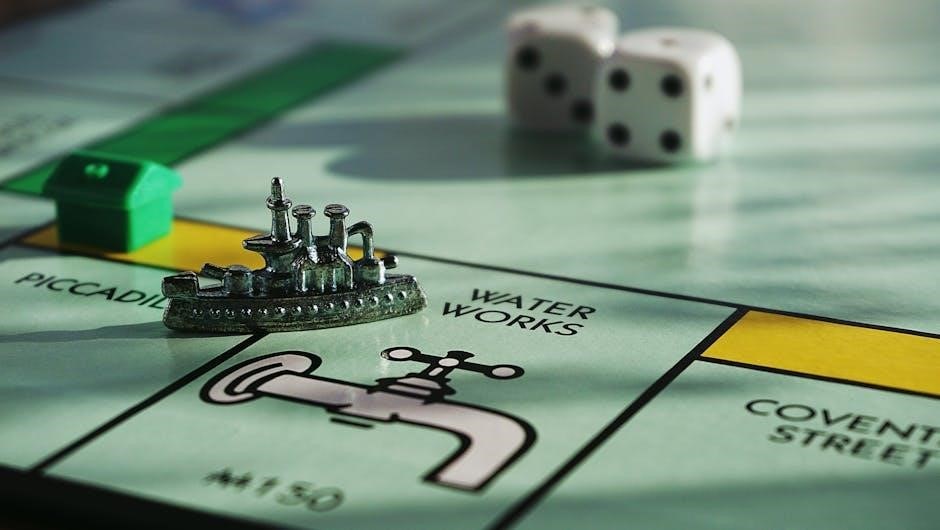
1.1 Overview of Craps as a Casino Game
Craps is a dynamic dice game featuring a shooter and two main phases: the come-out roll and the point phase. It combines strategy, luck, and social interaction, making it a classic casino favorite with structured rules and exciting gameplay.
Craps is one of the most popular and exhilarating casino games, known for its fast-paced action and social interaction. Played on a specially designed table, it involves one or more players taking turns as the shooter, rolling two dice. The game features two main phases: the come-out roll and the point phase. Players bet on various outcomes of the dice rolls, either against the house or other players. With its rich history and complex betting options, Craps offers a unique blend of luck, strategy, and camaraderie, making it a favorite among casino enthusiasts. Understanding the rules and etiquette is essential for a smooth gaming experience.
1.2 Basic Rules and Gameplay Structure
Craps begins with a shooter rolling the dice, aiming to achieve specific outcomes. The game starts with the come-out roll, where the shooter tries to establish a point by rolling a 4, 5, 6, 8, 9, or 10. If a 7 or 11 is rolled, the shooter wins immediately. Rolling a 2, 3, or 12 results in an instant loss. Once a point is set, the game enters the point phase, where the shooter must roll the point number again before rolling a 7 to win. The gameplay structure involves a series of rounds, with players placing bets on various outcomes, making it essential to understand the sequence and betting options for effective participation.

Craps Table Setup
A regulation craps table is large, oblong, and covered with a marked cloth indicating various betting areas. It features high walls, a rail for chip placement, and a dealer’s area with stacks of chips. The stickman uses a stick to manage the dice, ensuring smooth gameplay.
2.1 Layout of a Regulation Craps Table
A regulation craps table is oblong with rounded corners and high-walled sides. The table’s surface is covered with a marked cloth displaying various betting areas, including the pass line, don’t pass, odds, come, and field bets. The table is divided into sections for different types of wagers, with specific areas for proposition bets and hard ways. The stickman uses a long stick to manage the dice, and the dealer controls the chips and payouts. The layout is designed to accommodate multiple players, each with their own betting areas, ensuring efficient and organized gameplay. The table’s design promotes clarity and structure, essential for managing the game’s fast-paced nature.
2.2 Key Components of the Table
A regulation craps table features a cloth-covered surface with marked betting areas, including pass line, don’t pass, odds, come, and field bets. The table includes a stickman area for managing dice and dealers’ zones for handling chips and payouts. The chip rail surrounds the table for player bets, while the apron protects the table’s edges. Specific sections are dedicated to proposition bets and hard ways, offering diverse wagering options. The table’s design ensures efficient gameplay, with clear markings guiding players and dealers. The stickman uses a long stick to control dice movement, while dealers manage payouts and bet placements. These components work together to create a structured and dynamic gaming environment. The table’s layout is essential for maintaining the game’s integrity and flow.

Basic Rules of Craps
Craps is played with two dice, where players bet on outcomes. The shooter rolls, aiming to hit numbers like 7 or 11 on the come-out roll. If a point is set, the shooter must hit it before rolling a 7 to win. Rules vary slightly but follow standard guidelines for fairness and gameplay consistency across casinos. The game combines luck and strategy, with clear winning and losing conditions based on dice combinations. Understanding these rules is essential for effective play and enjoyment. The shooter’s role is central, and all bets are placed before each roll. The goal is to predict dice outcomes accurately. The game is fast-paced and requires attention to the rules and table dynamics. Players can bet on various outcomes, but the core rules remain consistent. The shooter’s performance determines the round’s outcome, making each roll suspenseful. The basic rules provide the foundation for more complex betting strategies and advanced gameplay options. The game’s simplicity and excitement make it a popular choice in casinos worldwide. The rules are designed to ensure fairness and transparency, allowing players to focus on their strategies. The shooter must follow proper etiquette and adhere to the rules to maintain a smooth game flow. The basic rules of craps are easy to learn but challenging to master, offering depth for both beginners and experienced players. The game’s rules are universal, making it accessible to players from all backgrounds. The shooter’s role is both privilege and responsibility, as their performance impacts all players at the table. The rules are enforced by dealers to ensure fair play and maintain the game’s integrity. The basic rules of craps provide a solid framework for enjoying the game responsibly and effectively. The game’s rules are designed to promote engagement and excitement while maintaining order at the table. The shooter must be aware of the rules to avoid penalties and ensure a positive experience for all players. The basic rules of craps are the cornerstone of the game, enabling players to navigate the table with confidence and make informed decisions.
3;1 The Role of the Shooter
The shooter is the player who rolls the dice in craps, central to the game’s progression. They must place bets on the pass or don’t pass line before rolling. The shooter’s primary goal is to roll a 7 or 11 on the come-out roll to win or avoid rolling a 2, 3, or 12 to lose. If a point is established, the shooter must roll that number again before rolling a 7 to win. The shooter continues rolling until they either win or lose, passing the dice to the next player. Proper dice handling and adherence to rules are essential for fair play.
The shooter’s performance determines the game’s outcome, making their role both exciting and pivotal. They must abide by casino rules, such as handling the dice with one hand and ensuring they bounce off the table. The shooter’s decisions and luck significantly impact the table’s dynamics, creating a suspenseful atmosphere. Understanding the shooter’s responsibilities is crucial for effective gameplay and maintaining the flow of the game. The shooter’s role combines strategy and chance, making it a key element of craps. Their actions set the pace and determine the results for all players involved in the round.
3.2 The Come Out Roll and Point Phase
The come-out roll initiates a new round in craps, determining the game’s direction. The shooter rolls the dice, and the outcome decides the next steps. A roll of 7 or 11 results in an immediate win for pass line bets, while a 2, 3, or 12 leads to a loss. If the shooter rolls 4, 5, 6, 8, 9, or 10, that number becomes the “point,” and the game enters the point phase. The shooter’s goal is to roll the point number again before rolling a 7. If they succeed, pass line bets win; if a 7 appears first, those bets lose. This phase is crucial as it extends the round and allows for additional betting opportunities. The suspense and strategy during this phase make craps engaging for players. The point phase continues until either the point or a 7 is rolled, concluding the round. Players can place various bets during this phase, enhancing the game’s excitement and complexity. The come-out roll and point phase are fundamental to craps, offering a mix of chance and strategy that defines the game’s appeal. Understanding these phases is essential for mastering craps and enjoying its dynamic nature.

Types of Bets in Craps
Craps offers various bets with unique rules and payouts, including Pass Line, Don’t Pass, Come, and Don’t Come. These bets form the core of the game’s betting options, providing players with multiple strategies and outcomes to explore during gameplay.
4.1 Pass Line Bet and Its Rules
The Pass Line Bet is a fundamental wager in craps, placed before the come-out roll. If the shooter rolls a 7 or 11, the bet wins immediately. If a 2, 3, or 12 is rolled, it loses outright. Any other number establishes a “point,” and the bet remains active until the shooter either rolls the point again or rolls a 7. The Pass Line Bet offers even money payouts, making it a popular choice for beginners and experienced players alike. Its straightforward rules and favorable odds contribute to its enduring popularity at the craps table.
4.2 Don’t Pass Bet and Its Rules
The Don’t Pass Bet is the opposite of the Pass Line Bet, making it a popular option for players betting against the shooter. Placed before the come-out roll, the bet wins if the shooter rolls a 2 or 3 and loses if a 7 or 11 is rolled. If a 12 is rolled, the bet is a push, meaning no one wins or loses. After a point is established, the Don’t Pass Bet wins if the shooter rolls a 7 before the point number. The bet offers a low house edge and is often favored by experienced players looking to hedge their risks. Its rules mirror the Pass Line Bet but with reversed outcomes, making it a strategic choice for those who prefer betting against the shooter.
4.3 Come Bet and Its Rules
The Come Bet is a versatile wager in craps that can be placed after the point has been established. It follows the same rules as the Pass Line Bet but offers more flexibility. Once the Come Bet is made, the next roll of the dice determines its outcome. If a 7 or 11 is rolled, the bet wins, while rolling a 2, 3, or 12 results in a loss. If any other number (4, 5, 6, 8, 9, or 10) is rolled, it becomes the “come point,” and the bet remains in place until either the come point or a 7 is rolled. The Come Bet is appealing because it allows players to engage in multiple betting sequences simultaneously, making the game more dynamic and strategic.
4.4 Don’t Come Bet and Its Rules
The Don’t Come Bet is the opposite of the Come Bet, offering a strategic way to wager against the shooter. It can be placed after the point is established and follows specific rules. If the shooter rolls a 2 or 3, the Don’t Come Bet wins. A roll of 7 or 11 results in a loss, while any other number (4, 5, 6, 8, 9, or 10) sets a “don’t come point.” The bet wins if a 7 is rolled before this point. Similar to the Don’t Pass Bet, the Don’t Come Bet allows players to hedge against the shooter’s success, making it a popular choice for those who prefer contrarian strategies in craps.

Advanced Bets in Craps

Advanced bets in craps include Odds, Place, Field, Any Craps, and Hop bets, offering diverse strategies and payouts that add depth to the game for experienced players.
5.1 Odds Bet and Its Payouts
The Odds bet in craps is a side wager placed after a point is established. It offers true odds with no house edge, making it highly favorable. The payout varies depending on the point number: 2:1 for points 4 and 10, 3:2 for 5 and 9, and 6:5 for 6 and 8. This bet is only available when a point is set during the point phase, making it a strategic choice for players seeking to maximize their potential winnings while minimizing the casino’s advantage. Understanding the Odds bet is crucial for any serious craps player aiming to optimize their gameplay.
5.2 Place Bets and Their Rules
Place bets allow players to wager on specific numbers (4, 5, 6, 8, 9, 10) to roll before a 7. Each number has its payout: 9:1 for 4 and 10, 7:5 for 5 and 9, and 7:6 for 6 and 8. These bets are active after the point is set and remain so until resolved. A 7 rolled before the chosen number results in a loss. Players can remove their Place bets at any time, offering flexibility. This bet type is popular for its straightforward nature and varied payout options, making it a strategic choice for players seeking specific number outcomes in craps.
5.3 Field Bet and Its Payout Odds
The Field bet is a one-roll wager that wins if a 2, 3, 4, 9, 10, 11, or 12 is rolled. It typically pays even money, except for 2 and 12, which often pay double. This bet is popular for its simplicity and frequent payouts, as it covers multiple numbers. However, the House edge is higher compared to other bets like the Pass Line. Players enjoy the Field bet for its excitement and potential for quick wins. It’s a great option for those looking for variety without complex rules, making it a staple in many craps strategies.
5.4 Any Craps Bet and Its Rules
The Any Craps bet is a one-roll wager that wins if the shooter rolls a 2, 3, or 12. It pays out at 7 to 1 odds but loses on any other number. This bet is simple and popular for its high-risk, high-reward nature. Players enjoy it for its immediate results, as it resolves quickly. The Any Craps bet is ideal for those seeking excitement and instant gratification, though it carries a higher House edge compared to other bets. Its straightforward rules make it accessible to newcomers while offering seasoned players a thrilling option to diversify their strategy and potentially boost their winnings in a single roll.

Special Bets in Craps
Special bets in Craps, like Hop Bets and Hard Ways, offer unique wagering options with specific payouts, adding variety and excitement for experienced players seeking higher risks and rewards.
6.1 Hop Bet and Its Variations
The Hop Bet is a one-roll wager that allows players to bet on a specific combination of dice outcomes, such as a pair (e.g., two fives) or a specific number pair (e.g., one and two). Variations include the “Three-Way Craps” and “Seven” options, which cover multiple combinations. This bet is popular for its high payouts, often 15:1 for pairs and 30:1 for specific pairs. The bet is decided quickly, adding excitement to the game. Hop Bets are ideal for players seeking immediate results and higher risk-reward scenarios. They are typically placed before the shooter rolls the dice, enhancing the game’s dynamic nature.
6.2 Hard Ways and Their Payouts
A Hard Ways bet is a wager that the shooter will roll a specific pair of numbers (e.g., two 4s, two 5s, etc.) before rolling a 7 or an “easy” combination of the same number. The most common Hard Way bets are for 4, 6, 8, and 10. Payouts vary but are typically high: 7:1 for Hard 4 and Hard 10, and 9:1 for Hard 6 and Hard 8. These bets are considered advanced and are placed in the “Hard Ways” section of the table. They remain active until resolved, making them a high-risk, high-reward option for experienced players. Understanding these bets can enhance your Craps strategy and add excitement to your gameplay.

Craps Strategy
Mastering Craps strategy involves understanding odds, managing bets, and minimizing the house edge. Focus on low-risk wagers like Pass Line and Odds bets to maximize your chances of winning consistently.
7.1 Basic Strategy for Beginners

For newcomers, a solid strategy starts with understanding the fundamentals. Focus on the Pass Line and Don’t Pass bets, as they offer the lowest house edge. Avoid risky propositions like Any Craps or Hard Ways, which have higher odds against you. Stick to the Odds bet when available, as it’s one of the fairest wagers in the game. Managing your bankroll is crucial; set limits and don’t chase losses. Observing the table dynamics and learning from experienced players can also enhance your decision-making. Consistency and patience are key to building a winning approach in Craps.
7.2 Managing Your Bankroll
Effective bankroll management is essential for a sustainable and enjoyable Craps experience. Start by setting a clear budget and sticking to it. Allocate a specific amount for each session and avoid exceeding it, even during winning streaks. Divide your bankroll into smaller, manageable portions to prolong your playtime. Avoid chasing losses by walking away when your budget is depleted. Prioritize responsible betting to ensure the game remains entertaining without financial strain.

Etiquette and Rules of Engagement
Respect all players and dealers. Handle dice carefully and avoid touching others’ bets. Keep the table organized and wish others good luck. Maintain responsible gambling habits.
8.1 Polite Customs at the Craps Table
At the craps table, it’s essential to maintain a respectful and courteous atmosphere. Always greet the dealer and other players upon arriving. Avoid touching or handling other players’ chips or bets, as this is considered impolite. When it’s your turn to shoot, ensure you handle the dice with care and respect. Wishing others good luck is common, but avoid unsolicited advice. Keep the table clean and avoid placing drinks or personal items on the playing surface. Remember to tip the dealers occasionally, especially if you’re on a winning streak. These customs enhance the overall enjoyment and social dynamic of the game.
8.2 Interaction with Dealers and Players
Interacting respectfully with dealers and players is crucial at the craps table. Always address dealers clearly and politely when placing bets or asking questions. Avoid touching or handling the dice excessively before your turn, as this can slow the game. When engaging with other players, maintain a positive attitude and congratulate others on their wins. Refrain from criticizing or offering unsolicited advice, as this can create tension. Keep the table area tidy and avoid placing personal items on the playing surface. Following these customs ensures a smooth and enjoyable experience for everyone involved. Remember, teamwork and camaraderie are key to fostering a pleasant environment.
Craps is a vibrant game blending luck and strategy. Understanding its rules enhances enjoyment and success. Continuous learning and practice are key to mastering this exciting casino classic.
9;1 Summary of Key Points
Craps is a dynamic dice game where players take turns as the shooter, with rounds divided into the Come Out Roll and Point Phase. Understanding basic rules, such as Pass Line and Don’t Pass bets, is essential for beginners. Advanced strategies include Odds Bets and Place Bets, which offer better payouts. Etiquette plays a significant role, emphasizing polite interaction with dealers and fellow players. Managing bankrolls and avoiding high-risk bets like Any Craps are crucial for sustainable play. Mastery requires practice and a deep understanding of the game’s structure and probabilities, making Craps both challenging and rewarding for players of all skill levels.
9.2 Final Tips for Playing Craps
Mastering Craps begins with understanding its rules and etiquette. Start with simple bets like Pass Line and avoid complex wagers initially. Always manage your bankroll to ensure sustainable play. Don’t chase losses or bet impulsively. Learn basic strategies, such as taking Odds bets to improve your chances. Practice patience and observe the table dynamics before joining. Avoid Proposition bets due to their high house edge. Stay polite and respectful to dealers and fellow players. Lastly, take advantage of free online resources and guides to refine your skills before playing in a real casino setting. Consistent learning and discipline are key to enjoying Craps long-term.